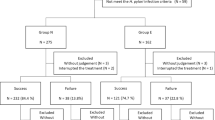Summary
Although dyspeptic symptoms are very common, the vast majority of patients have modest symptoms and rarely seek medical advice. The major organic causes of dyspepsia are chronic peptic ulcer disease, gastro-oesophageal reflux disease and malignancy. Functional dyspepsia is very common.
In the fit elderly patient, prompt investigation may be more appropriate than empirical treatment in view of the higher proportion of patients with organic disease and the likelihood of malignancy. The symptoms of peptic ulceration and gastro-oesophageal reflux disease are often atypical in the elderly population. Frail patients, especially those with multiple pathology, should be treated empirically in the first instance. Empirical treatment should be with histamine H2-receptor antagonists or prokinetic agents. Drug treatment is not always required in dyspepsia and should be avoided where possible, especially given the increased risk of drug interactions and poor compliance in the elderly.
For those patients with documented non-malignant organic disease, the advent of the H2-receptor antagonists, proton pump inhibitors, prokinetic drugs and regimens which eradicate Helicobacter pylori means that treatment is almost always successful.
Similar content being viewed by others
References
Heading RC. Definitions of dyspepsia. Scand J Gastroenterol 1991; 26 Suppl. 182: 1–6
Jones R, Lydeard S. Prevalence of symptoms of dyspepsia in the community. BMJ 1989; 298: 30–2
Jones R, Lydeard S. Dyspepsia in the community: a follow-up study. Br J Clin Pract 1992; 46: 95–7
Jones RH, Lydeard SE, Hobbs FDR, et al. Dyspepsia in England and Scotland. Gut 1990; 31: 401–5
Kay L. Prevalence, incidence and prognosis of gastrointestinal symptoms in a random sample of an elderly population. Age Ageing 1994; 23: 146–9
Royal College of General Practitioners, Office of Population Censuses and Surveys, Department of Health and Social Security. Morbidity statistics from general practice 1981–1982. Third national study. HMSO: London, 1986
Lydeard S, Jones R. Factors affecting the decision to consult with dyspepsia: comparison of consulters and non-consulters. J R Coll Gen Pract 1989; 39: 495–8
Talley NJ, Zinsmeister AR, Schleck CD, et al. Dyspepsia and dyspepsia subgroups: a population-based study. Gastroenterology 1992; 102: 1259–68
Waldron B, Cullen PT, Kumar R, et al. Evidence for hypomotility in non-ulcer dyspepsia: a prospective multifactorial study. Gut 1991; 32: 246–51
Klauser AG, Voderholzer WA, Knesewitsch PA, et al. What is behind dyspepsia? Dig Dis Sci 1993; 38: 147–54
Walt R, Katschinski B, Logan R, et al. Rising frequency of ulcer perforation in elderly people in the United Kingdom. Lancet 1986; i: 489–92
Gilinsky NH. Peptic ulcer disease in the elderly. Scand J Gastroenterol 1988; 23 Suppl. 146: 191–200
Klauser AG, Schindlbeck NE, Müller-Lissner SA. Symptoms in gastro-oesophageal reflux disease. Lancet 1990; 335: 205–8
Räihä I, Hietanen E, Sourander L. Symptoms of gastro-oesophageal reflux disease in elderly people. Age Ageing 1991; 20: 365–70
Hallissey MT, Allum WH, Jewkes AJ, et al. Early detection of gastric cancer. BMJ 1990; 301: 513–5
Jones DM, Eldridge J, Fox AJ, et al. Antibody to the gastric campylobacter-like organism (‘Campylobacter pyloridis’) — clinical correlations and distribution in the normal population. J Med Microbiol 1986; 22: 57–62
O’Riordan TG, Tobin A, Ó’Moráin C. Helicobacter pylori infection in elderly dyspeptic patients. Age Ageing 1991; 20: 189–92
Dooley CP, Weiner JM, Larson AW. Endoscopy or radiography? The patient’s choice. A prospective comparative survey of patient acceptability of upper gastrointestinal endoscopy and radiography. Am J Med 1986; 80: 203–7
Cooper BT, Neumann CS. Upper gastrointestinal endoscopy in patients aged 80 years or more. Age Ageing 1986; 15: 343–9
Health and Public Policy Committee, American College of Physicians. Endoscopy in the evaluation of dyspepsia. Ann Intern Med 1985; 102: 266–9
Bytzer P, Hansen JM, Schaffalitzky de Muckadell OB. Empirical H2-blocker therapy or prompt endoscopy in management of dyspepsia. Lancet 1994; 343: 811–6
Williams B, Luckas M, Ellingham JHM, et al. Do young patients with dyspepsia need investigation? Lancet 1988; ii: 1349–51
Lockhart SP, Schofield PM, Gribble RJN, et al. Upper gastrointestinal endoscopy in the elderly. BMJ 1985; 290: 283
Fjøsne U, Kleveland PM, Waldum H, et al. The clinical benefit of routine upper gastrointestinal endoscopy. Scand J Gastroenterol 1986; 21: 433–40
Jones R. What happens to patients with non-ulcer dyspepsia after endoscopy? Practitioner 1988; 232: 75–8
Halter F, Miazza B, Brignoli R. Cisapride or cimetidine in the treatment of functional dyspepsia. Results of a double-blind, randomised, Swiss multicentre study. Scand J Gastroenterol 1994; 29: 618–23
Rösch W. Cisapride in non-ulcer dyspepsia. Results of a placebo-controlled trial. Scand J Gastroenterol 1987; 22: 161–4
Van Outryve M, De Nutte N, Van Eeghem P, et al. Efficacy of cisapride in functional dyspepsia resistant to domperidone or metoclopramide: a double-blind, placebo-controlled study. Scand J Gastroenterol 1993; 28 Suppl. 195: 47–53
Hausken T, Berstad A. Cisapride treatment of patients with non-ulcer dyspepsia and erosive prepyloric changes. A double-blind, placebo-controlled trial. Scand J Gastroenterol 1992; 27: 213–7
Talley NJ. Drug treatment of functional dyspepsia. Scand J Gastroenterol 1991; 26 Suppl. 182: 47–60
Nyrén O, Adami H-O, Bates S, et al. Absence of therapeutic benefit from antacids or cimetidine in non-ulcer dyspepsia. N Engl J Med 1986; 314: 339–43
Carvalhinhos A, Fidalgo P, Freire A, et al. Cisapride compared with ranitidine in the treatment of functional dyspepsia. Eur J Gastroenterol Hepatol 1995; 7: 411–7
Author information
Authors and Affiliations
Rights and permissions
About this article
Cite this article
Pound, S.E., Heading, R.C. Diagnosis and Treatment of Dyspepsia in the Elderly. Drugs & Aging 7, 347–354 (1995). https://doi.org/10.2165/00002512-199507050-00003
Published:
Issue Date:
DOI: https://doi.org/10.2165/00002512-199507050-00003




